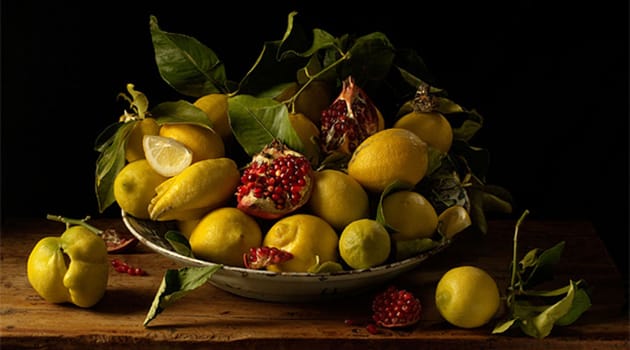Natura Morta
By Paulette Tavormina
in
Galleries
—
04 Mar 2013
Inspired by Old Master still lifes, Paulette Tavormina’s photographs lie in an uncanny valley of beauty—dew-dappled flowers combined with jumping goldfish.
Paulette Tavormina’s photographs lie in an uncanny valley of beauty, mimicking the still lifes of the Old Masters, then doing them one better with dew-dappled flowers and jumping goldfish.
Natura Morta Robert Mann Gallery in New York City through March 9, 2013.
All images © copyright the artist, all rights reserved.
© Paulette Tavormina, Red Cherries and Plums, After G.G. , 2011. Courtesy Robert Mann Gallery, New York. © Paulette Tavormina, Lemons and Pomegranates, After J.V.H. , 2010. Courtesy Robert Mann Gallery, New York. © Paulette Tavormina, Peaches and Morning Glories, After G.G. , 2010. Courtesy Robert Mann Gallery, New York. © Paulette Tavormina, Watermelon Radishes , 2008. Courtesy of Robert Mann Gallery, New York. © Paulette Tavormina, Yellow Cherries and Crab Apples, After G.G. , 2011. Courtesy Robert Mann Gallery, New York. © Paulette Tavormina, Oysters and Lemon, After W.C.H. , 2008. Courtesy Robert Mann Gallery, New York. © Paulette Tavormina, Flowers and Fish IV, After G.V.S. , 2012. Courtesy Robert Mann Gallery, New York. © Paulette Tavormina, Flowers and Fish III, After G.V.S. , 2012. Courtesy Robert Mann Gallery, New York. © Paulette Tavormina, Strawberries , 2009. Courtesy Robert Mann Gallery, New York. © Paulette Tavormina, Figs and Morning Glories, After G.F. , 2009. Courtesy Robert Mann Gallery, New York.











